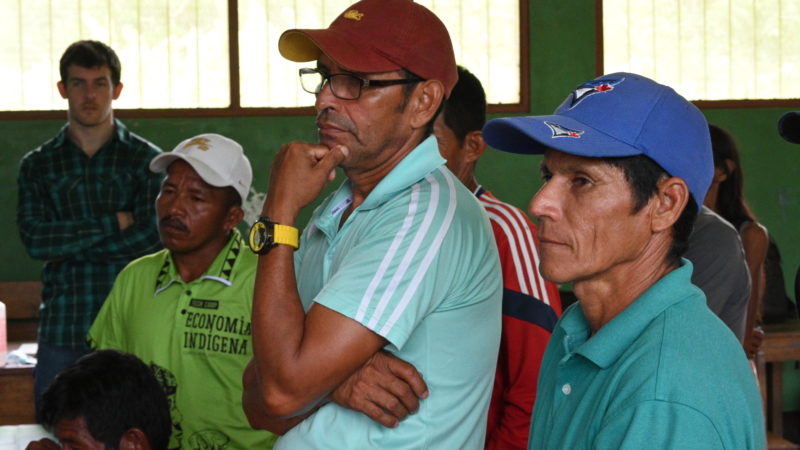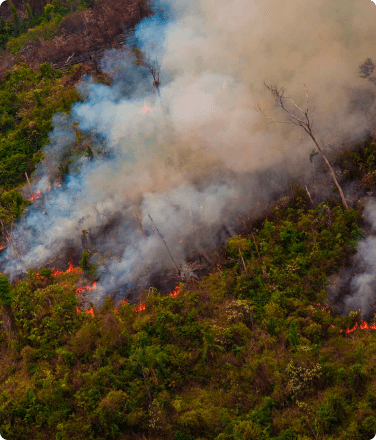Homes along the Amazon River in Iquitos, Peru. IMAGE CREDIT: Deb Dowd
The United Nations’s Intergovernmental Panel on Climate Change (IPCC) recently released a report about the future impacts of climate change on ecosystems and human life.
In this strongly worded report, researchers state that destruction of the rainforest could lead to catastrophic destabilization of the global water system. The effects of such a shift would be felt far and wide.
Yet indigenous peoples are among the groups most disproportionately negatively affected by climate change. Rainforest Foundation US’s (RFUS) indigenous partners are already seeing these effects, which the new IPCC report states will only become worse.
“This was the driest season of my entire life,” says Andrade Carihuasari Dasilva, 53-year-old apu, or village leader, in Peru’s Yahuma II Zona, an indigenous Ticuna community that relies on the adjacent Yahuma River.
“When it gets really dry [and the river dries up], the closest water is more than six miles from our village. It takes two hours to walk there, then two hours back, and you only end up with enough drinking water to sustain your family for a single day.”
Forests regulate atmospheric moisture and rainfall, meaning that without forests, the whole planet faces unpredictable water availability. This could spell extreme drought and flooding for all of us. Because forests produce, transport, and regulate rainfall, deforestation paired with a changing climate is expected to make rainfall and water availability increasingly unpredictable.
The IPCC report emphasizes that evaporation from soil and plant surfaces, and the release of water directly by plants, cause at least 40% of rainfall. On a single day, a robust tree with a 66-foot canopy pumps around 290 gallons of water into the atmosphere. Water in the air from forests can actually be seen via satellite: Over most of the tropics, air that passes over forests produces at least twice as much rain as air that passes over landscapes with fewer trees. Forests not only produce moisture, they also help to circulate that moisture as rain, creating low pressure regions that generate winds to push rain across the continent.

Loss of forests makes this cycle less reliable, affecting rainfall up to thousands of miles away. Climate models have predicted that large scale deforestation could reduce rainfall in some areas by as much as 30%. Extreme droughts have already affected the Amazon and Central American rainforests in recent years.
And drought doesn’t just mean loss of access to drinking water. It also means isolation from the outside world, without rivers as passageways.
In Panama’s Darién, indigenous communities rely heavily on rivers for travel. Carlos Doviaza, an indigenous Emberá and RFUS partner, says the Chucunaque River that runs through indigenous peoples’ comarcas reduces to about half its size during the dry season.
Predicting and traveling on the river’s flows is important to indigenous communities here. “The rivers are roads for indigenous people,” says Doviaza. “In the dry season rivers are not as transitable. So it takes many more hours to get around, compared to the rainy season, when there’s enough water in the river to travel. Traveling to other communities is very delayed, and you have to carry less weight.”
Back in Peru, Carihuasari Dasilva is concerned by how river volume affects his community’s access to markets. “We make our money selling crops on the market: watermelon, rice, vegetables,” he says. “But during the dry season, we can’t deliver our crops to the market in Leticia because the river has dried up, and so our produce rots in the field. Then once it is the rainy season again, there’s an abundance. At that point we can get to the market, but no one wants to buy our produce. We can’t even give it away.”
While indigenous communities may be isolated by rivers drying up, drier conditions can also make the land more accessible—to those who want to extract resources. “During the rainy season the roads are really bad, so loggers don’t try to transport wood during that time,” says Michael McGarrell, indigenous Patamona and Geographic Information Systems specialist for the Amerinidian Peoples Association, an RFUS partner in Guyana. “But during the dry season it’s easier, and they take the opportunity and maximize that.” As climate change influences longer dry seasons, threats to rainforests and their peoples increase.
In the Darién, “When it doesn’t rain, dirt roads harden, opening up routes that lead straight into the comarca—to where wood is available,” says Doviaza.
“It’s not only the dry season, it’s also the season of logging.”
The effects of forest destruction and climate change mean while some areas receive less precipitation and more dry spells, others can receive heavier precipitation.
During the most recent dry season in Panama’s Darién, forest communities note unusually heavy rain. In Guyana, too, seasons have shifted. “The wet and dry seasons inform preparing and planting fields,” says RFUS Senior Geographer Cameron Ellis. “Now the distinction is a lot fuzzier, and some communities say they haven’t even had a dry season this year, so crops were lost.”

Shifts in expected seasonality of the rainy and dry seasons create challenges adapting traditional practices dependent upon reliable seasons.
“In these times it is difficult to predict the rainy or dry season,” says McGarrell. “This has had an impact on our food security as we live off the land. Our farming seasons have been negatively impacted as a result of the uncertainty of the seasons. The spawning season for fishes has changed, directly affecting fishing for the people.”
The combination of deforestation and climate change impacts on rainfall means nearly half a billion people globally now live in areas with “unfamiliar” seasonal precipitation levels, compared with historic rainfall patterns.
To stop extreme changes in rainfall, and catastrophic impacts for indigenous forest communities—and for the rest of the world—we need to combat climate change by keeping forests standing.
Research shows the most effective way to protect forests is through supporting indigenous peoples’ rights to manage their own forested lands, protecting forests even better than national parks.
RFUS’s partners are fighting to achieve land titling, and ensure indigenous peoples are able to protect their ancestral forests. We also partner with indigenous peoples’ organizations to equip communities with technology, to track and report illegal forest destruction on their land, via our Rainforest Alert program. Through a partnership with the Mesoamerican Alliance of Peoples and Forests, we are also launching direct financing for indigenous and local forest communities, to channel resources straight to those forest defenders.
“The entire livelihood of our people is impacted as a result of the unpredictability of the weather,” says McGarrell.
Through supporting indigenous peoples’ fight against deforestation and climate change, we can ensure forests will continue to provide us with reliable rainfall, in rainforests and around the world.



